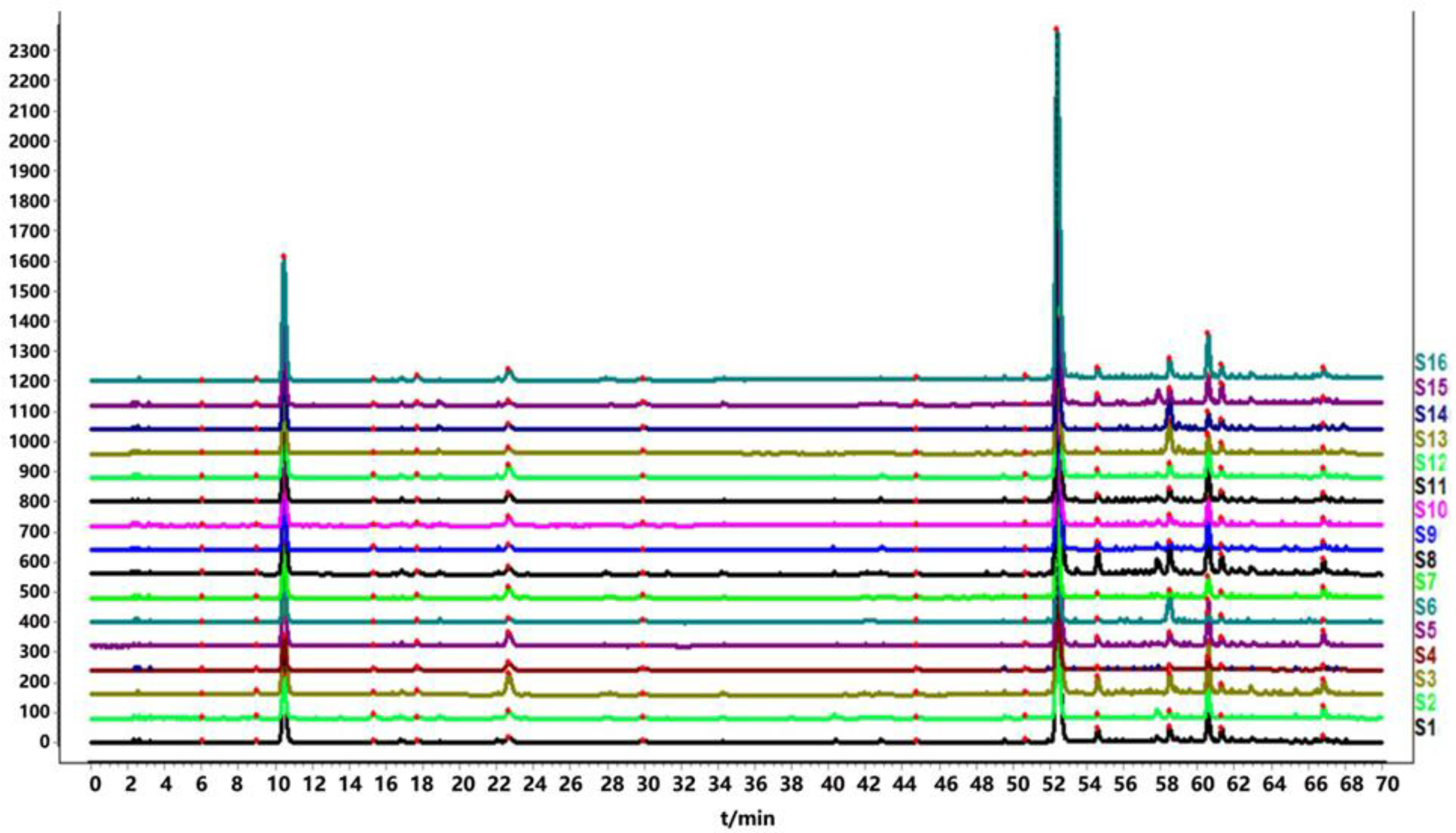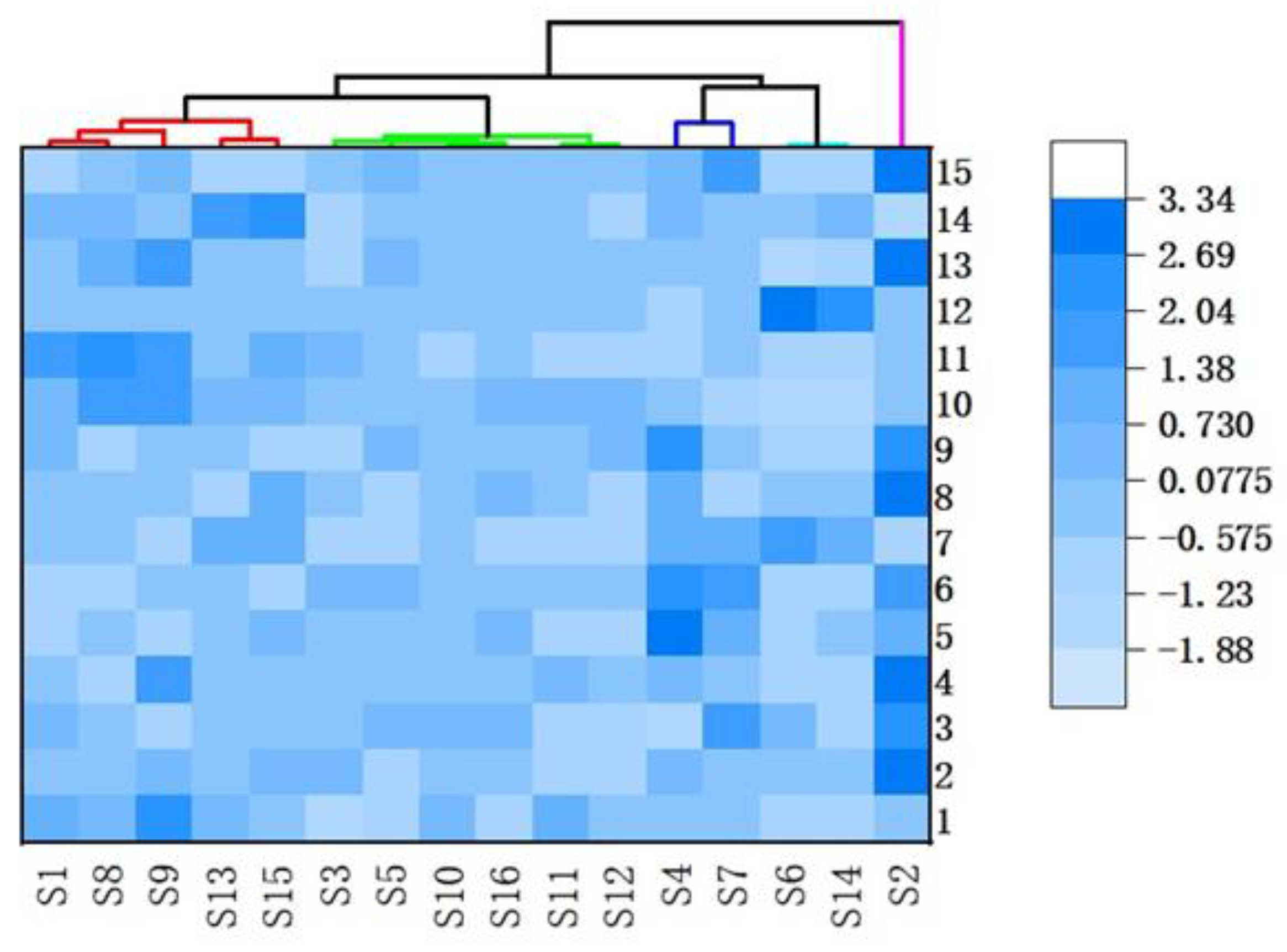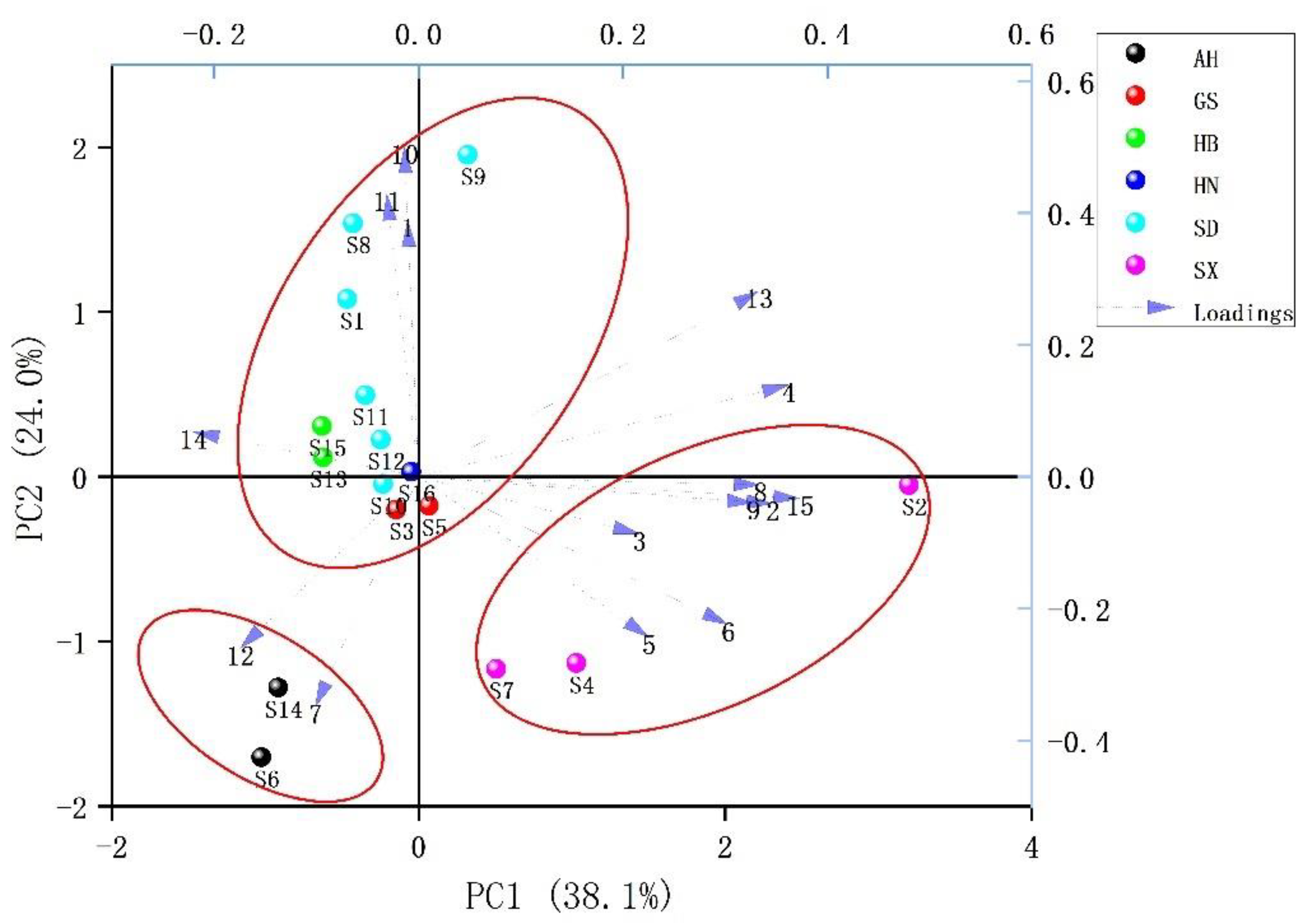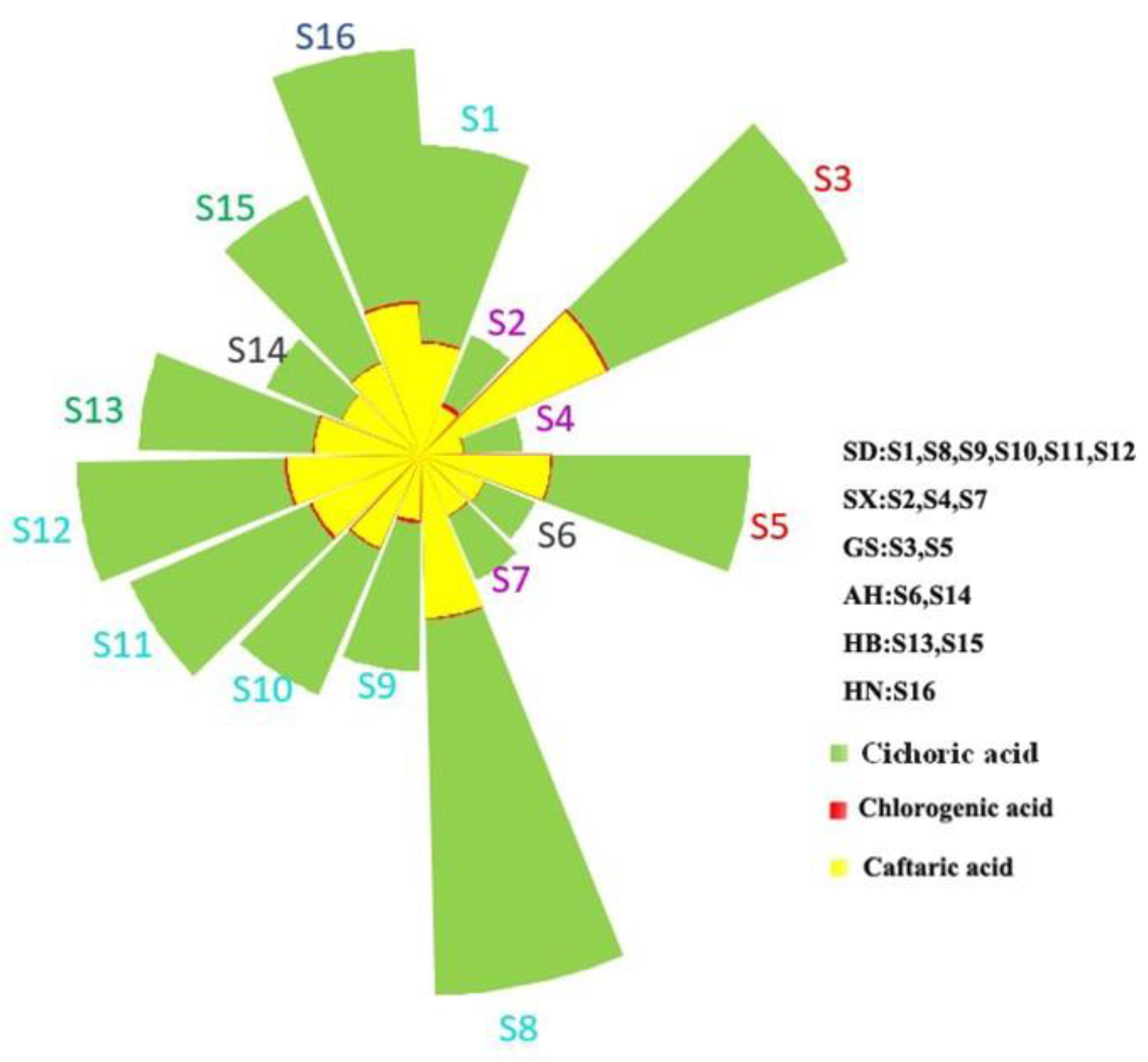Application of HPLC Fingerprint Combined with Chemical Pattern Recognition and Multi-Component Determination in Quality Evaluation of Echinacea purpurea (L.) Moench
Abstract
:1. Introduction
2. Results
2.1. Method Validation for Fingerprint Analysis
2.2. Method Validation for Quantitative Analysis
2.3. HPLC Fingerprint Establishment
2.3.1. Identification of Common Peaks
2.3.2. Similarity Analysis of the HPLC Fingerprints
2.3.3. Verification of HPLC Fingerprints of Five Batches of Commercially Available Echinacea pupurea (L.) Moench from Different Origins
2.4. Chemical Pattern Recognition
2.4.1. Hierarchical Cluster Analysis (HCA)
2.4.2. Principal Component Analysis (PCA)
2.4.3. Determination of the Contents of Three Phenolic Acids in Echinacea pupurea (L.) Moench Samples
3. Discussion
4. Materials and Methods
4.1. Plant Materials, Chemicals, and Reagents
4.2. Instruments
4.3. HPLC Fingerprint Chromatogram of Echinacea purpurea (L.) Moench
4.4. Validation of the HPLC Fingerprints Method
4.5. Determination of Three Phenolic Acids in Echinacea purpurea (L.) Moench
4.5.1. Preparation of Mixed Standard Solution and Sample Solution
4.5.2. Chromatographic Conditions
4.6. Validation of the Quantitative Method
4.7. Data Analysis
5. Conclusions
Author Contributions
Funding
Institutional Review Board Statement
Informed Consent Statement
Data Availability Statement
Conflicts of Interest
Sample Availability
Abbreviations
References
- United States Pharmacopeial Convention. The United States Pharmacopeia: USP 32-The National Formulary: NF 27; United States Pharmacopeial Convention: Rockville, MD, USA, 2009. [Google Scholar]
- Linde, K.; Barrett, B.; Wölkart, K.; Bauer, R.; Melchart, D. Echinacea for preventing and treating the common cold. Cochrane Database Syst. Rev. 2006, 73, CD000530. [Google Scholar] [CrossRef]
- Sharifi-Rad, M.; Mnayer, D.; Morais-Braga, M.F.B.; Carneiro, J.N.P.; Bezerra, C.F.; Coutinho, H.D.M.; Salehi, B.; Martorell, M.; Contreras, M.D.M.; Soltani-Nejad, A.; et al. Echinacea plants as antioxidant and antibacterial agents: From traditional medicine to biotechnological applications. Phytother. Res. 2018, 32, 1653–1663. [Google Scholar] [CrossRef] [PubMed]
- Ross, S.M. Echinacea purpurea: A Proprietary Extract of Echinacea purpurea Is Shown to Be Safe and Effective in the Prevention of the Common Cold. Holist. Nurs. Pract. 2016, 30, 54–57. [Google Scholar] [CrossRef]
- Dobrange, E.; Peshev, D.; Loedolff, B.; Van den Ende, W. Fructans as Immunomodulatory and Antiviral Agents: The Case of Echinacea. Biomolecules 2019, 9, 615. [Google Scholar] [CrossRef]
- Cheng, Z.-Y.; Sun, X.; Liu, P.; Lin, B.; Li, L.-Z.; Yao, G.-D.; Huang, X.-X.; Song, S.-J. Sesquiterpenes from Echinacea purpurea and their anti-inflammatory activities. Phytochemistry 2020, 179, 112503. [Google Scholar] [CrossRef]
- Aarland, R.C.; Bañuelos-Hernández, A.E.; Fragoso-Serrano, M.; Sierra-Palacios, E.D.C.; de León-Sánchez, F.D.; Pérez-Flores, L.J.; Rivera-Cabrera, F.; Mendoza-Espinoza, J.A. Studies on phytochemical, antioxidant, anti-inflammatory, hypoglycaemic and antiproliferative activities of Echinacea purpurea and Echinacea angustifolia extracts. Pharm. Biol. 2016, 55, 649–656. [Google Scholar] [CrossRef]
- Bruni, R.; Brighenti, V.; Caesar, L.K.; Bertelli, D.; Cech, N.B.; Pellati, F. Analytical methods for the study of bioactive compounds from medicinally used Echinacea species. J. Pharm. Biomed. Anal. 2018, 160, 443–477. [Google Scholar] [CrossRef] [PubMed]
- Xu, W.; Zhu, H.; Hu, B.; Cheng, Y.; Guo, Y.; Yao, W.; Qian, H. Echinacea in hepatopathy: A review of its phytochemistry, pharmacology, and safety. Phytomedicine 2021, 87, 153572. [Google Scholar] [CrossRef] [PubMed]
- Zhang, S.; Zhang, J.-J.; Zhao, Y.-M.; Fei, W.-T.; Wang, L.-Y.; Wang, C. Study on literature of Echinacea purpurea and discussion on its herbalization. Zhongguo Zhong Yao Za Zhi 2020, 45, 978–983. [Google Scholar] [CrossRef] [PubMed]
- Li, F.; Li, J.; Li, N. Application of Cichoric Acid in the Preparation of Drugs Against Respiratory Syncytial Virus. CN107050010A, 6 March 2017. [Google Scholar]
- Xin, X.U.; Hua-Wen, Q.I.; De-Song, G.; Xin-Na, C.; Lei, J.; Hong-Li, J.; Chao-Ran, W.; Yan-Fang, L.; Xin-Miao, L. UPLC quantitative fingerprint research on Gardeniae Fructus based on chemical pattern recognition technology. Zhongguo Zhong Yao Za Zhi 2020, 45, 4416–4422. [Google Scholar] [CrossRef] [PubMed]
- Cao, X.; Sun, L.; Li, D.; You, G.; Wang, M.; Ren, X. Quality Evaluation of Phellodendri Chinensis Cortex by Fingerprint–Chemical Pattern Recognition. Molecules 2018, 23, 2307. [Google Scholar] [CrossRef] [PubMed]
- Zhu, L.; Fang, L.; Li, Z.; Xie, X.; Zhang, L. A HPLC fingerprint study on Chaenomelis Fructus. BMC Chem. 2019, 13, 7. [Google Scholar] [CrossRef] [PubMed]
- Zhang, H.; Chen, Y.; Wang, J.-N.; Jiang, H.-J.; Shen, X.-W.; Yan, J.-Z. Application of fingerprint technology in quality evaluation and process control of traditional Chinese medicine formula granules. Zhongguo Zhong Yao Za Zhi 2018, 43, 3822–3827. [Google Scholar] [CrossRef] [PubMed]
- Gui-Ya, Y.; Ya-Qing, C.; Zi-Jing, X.; Jun-Na, S.; Dan, Z.; Yu-Guang, Z.; Long, G. Quality control of Dioscoreae Nipponicae Rhizoma based on fingerprint and quantitative analysis. Zhongguo Zhong Yao Za Zhi 2020, 45, 4949–4956. [Google Scholar] [CrossRef] [PubMed]






| Components | Regression Equation | R2 | Linear Ranges (μg/mL) | LOD (μg/mL) | LOQ (μg/mL) |
|---|---|---|---|---|---|
| Caftaric acid | Y = 14.006X − 1.3253 | 0.9995 | 7.142~198.317 | 1.101 | 3.050 |
| Chlorogenic acid | Y = 18.216X + 0.5184 | 0.9995 | 1.821~39.634 | 0.691 | 1.778 |
| Cichoric acid | Y = 28.312X − 494.63 | 0.9997 | 41.867~994.947 | 17.909 | 19.113 |
| Sample No. | Standard Fingerprint “R” | Y1 | Y2 | Y3 | Y4 | Y5 | Standard Fingerprint (New) |
|---|---|---|---|---|---|---|---|
| Standard fingerprint “R” | 1.000 | 0.977 | 0.989 | 0.996 | 0.988 | 0.979 | 0.997 |
| Y1 | 0.977 | 1.000 | 0.986 | 0.976 | 0.985 | 0.958 | 0.984 |
| Y2 | 0.989 | 0.986 | 1.000 | 0.991 | 0.993 | 0.972 | 0.995 |
| Y3 | 0.996 | 0.976 | 0.991 | 1.000 | 0.993 | 0.98 | 0.998 |
| Y4 | 0.988 | 0.985 | 0.993 | 0.993 | 1.000 | 0.965 | 0.993 |
| Y5 | 0.979 | 0.958 | 0.972 | 0.98 | 0.965 | 1.000 | 0.986 |
| Standard fingerprint (new) | 0.997 | 0.984 | 0.995 | 0.998 | 0.993 | 0.986 | 1.000 |
| Common Peak No. | Retention Time (Min) | S1 | S2 | S3 | S4 | S5 | S6 | S7 | S8 | S9 | S10 | S11 | S12 | S13 | S14 | S15 | S16 |
|---|---|---|---|---|---|---|---|---|---|---|---|---|---|---|---|---|---|
| 1 | 6.061 | 0.012 | 0.007 | 0.003 | 0.008 | 0.004 | 0.005 | 0.006 | 0.010 | 0.018 | 0.009 | 0.011 | 0.008 | 0.010 | 0.005 | 0.007 | 0.005 |
| 2 | 8.967 | 0.020 | 0.053 | 0.023 | 0.027 | 0.013 | 0.021 | 0.022 | 0.017 | 0.026 | 0.018 | 0.013 | 0.013 | 0.020 | 0.021 | 0.024 | 0.022 |
| 3 (reference peak) | 10.462 | 1.000 | 1.000 | 1.000 | 1.000 | 1.000 | 1.000 | 1.000 | 1.000 | 1.000 | 1.000 | 1.000 | 1.000 | 1.000 | 1.000 | 1.000 | 1.000 |
| 4 | 15.315 | 0.025 | 0.121 | 0.014 | 0.035 | 0.015 | 0.013 | 0.019 | 0.013 | 0.071 | 0.023 | 0.034 | 0.026 | 0.019 | 0.007 | 0.017 | 0.022 |
| 5 | 17.706 | 0.029 | 0.054 | 0.034 | 0.091 | 0.043 | 0.032 | 0.062 | 0.033 | 0.029 | 0.034 | 0.030 | 0.031 | 0.043 | 0.035 | 0.043 | 0.047 |
| 6 | 22.658 | 0.082 | 0.260 | 0.200 | 0.329 | 0.189 | 0.110 | 0.264 | 0.087 | 0.144 | 0.146 | 0.130 | 0.164 | 0.125 | 0.117 | 0.072 | 0.126 |
| 7 | 29.913 | 0.036 | 0.029 | 0.017 | 0.074 | 0.026 | 0.089 | 0.074 | 0.032 | 0.027 | 0.042 | 0.028 | 0.019 | 0.070 | 0.075 | 0.066 | 0.031 |
| 8 | 44.707 | 0.015 | 0.052 | 0.016 | 0.028 | 0.014 | 0.014 | 0.014 | 0.018 | 0.018 | 0.016 | 0.014 | 0.011 | 0.011 | 0.018 | 0.030 | 0.024 |
| 9 | 50.649 | 0.021 | 0.042 | 0.013 | 0.045 | 0.022 | 0.010 | 0.014 | 0.011 | 0.017 | 0.014 | 0.019 | 0.025 | 0.020 | 0.010 | 0.010 | 0.019 |
| 10 | 52.334 | 3.442 | 2.616 | 2.547 | 2.530 | 2.975 | 1.387 | 1.948 | 4.571 | 4.380 | 2.992 | 3.230 | 3.052 | 3.193 | 1.778 | 3.578 | 3.290 |
| 11 | 54.529 | 0.130 | 0.070 | 0.090 | 0.059 | 0.066 | 0.042 | 0.063 | 0.152 | 0.126 | 0.057 | 0.058 | 0.054 | 0.080 | 0.051 | 0.107 | 0.079 |
| 12 | 58.486 | 0.139 | 0.128 | 0.112 | 0.093 | 0.119 | 0.628 | 0.103 | 0.197 | 0.133 | 0.107 | 0.108 | 0.112 | 0.142 | 0.545 | 0.168 | 0.141 |
| 13 | 60.538 | 0.325 | 0.657 | 0.259 | 0.296 | 0.379 | 0.145 | 0.316 | 0.425 | 0.498 | 0.273 | 0.312 | 0.323 | 0.293 | 0.212 | 0.277 | 0.299 |
| 14 | 61.271 | 0.119 | 0.028 | 0.042 | 0.095 | 0.070 | 0.086 | 0.076 | 0.115 | 0.076 | 0.068 | 0.081 | 0.055 | 0.154 | 0.109 | 0.188 | 0.073 |
| 15 | 66.796 | 0.045 | 0.215 | 0.073 | 0.104 | 0.114 | 0.041 | 0.168 | 0.090 | 0.102 | 0.079 | 0.075 | 0.073 | 0.051 | 0.057 | 0.047 | 0.064 |
| Peak No. | PC1 | PC2 | PC3 | PC4 |
|---|---|---|---|---|
| 1 | −0.011 | 0.389 | 0.031 | 0.224 |
| 2 | 0.346 | −0.041 | 0.361 | 0.013 |
| 3 | 0.216 | −0.087 | 0.374 | −0.286 |
| 4 | 0.362 | 0.139 | 0.145 | −0.065 |
| 5 | 0.225 | −0.244 | −0.137 | 0.507 |
| 6 | 0.303 | −0.225 | −0.334 | 0.154 |
| 7 | −0.101 | 0.349 | 0.321 | 0.388 |
| 8 | 0.334 | −0.012 | 0.324 | 0.085 |
| 9 | 0.328 | −0.040 | −0.213 | 0.270 |
| 10 | −0.014 | 0.500 | −0.032 | 0.159 |
| 11 | −0.031 | 0.429 | 0.205 | 0.147 |
| 12 | −0.175 | −0.261 | 0.398 | −0.163 |
| 13 | 0.333 | 0.281 | 0.079 | −0.073 |
| 14 | −0.221 | 0.068 | 0.340 | 0.511 |
| 15 | 0.373 | −0.033 | −0.021 | −0.106 |
| Sample No. | Caftaric Acid (mg/g) | Chlorogenic Acid (mg/g) | Cichoric Acid (mg/g) |
|---|---|---|---|
| S1 | 4.688 | 0.091 | 8.259 |
| S2 | 2.180 | 0.202 | 3.098 |
| S3 | 8.592 | 0.093 | 11.103 |
| S4 | 1.770 | 0.048 | 2.493 |
| S5 | 5.481 | 0.064 | 8.343 |
| S6 | 2.906 | 0.029 | 2.272 |
| S7 | 2.793 | 0.039 | 2.969 |
| S8 | 6.899 | 0.070 | 15.874 |
| S9 | 2.757 | 0.151 | 6.250 |
| S10 | 4.305 | 0.075 | 6.647 |
| S11 | 4.999 | 0.131 | 8.264 |
| S12 | 5.639 | 0.111 | 8.792 |
| S13 | 4.479 | 0.066 | 7.350 |
| S14 | 3.611 | 0.020 | 3.453 |
| S15 | 4.184 | 0.054 | 7.682 |
| S16 | 6.358 | 0.107 | 10.622 |
| Sample No. | Chinese Name | Latin Name | Cultivation Area |
|---|---|---|---|
| S1 | Zizhuiju | Echinacea pupurea (L.) Moench | Baicaoyuan Experimental Field A, Shandong University of Traditional Chinese Medicine, Changqing District, Jinan City, Shandong Province, China |
| S2 | Zizhuiju | Echinacea pupurea (L.) Moench | Jinshan Village, Lantian County, Xi’an City, Shaanxi Province, China |
| S3 | Zizhuiju | Echinacea pupurea (L.) Moench | Suzhou District, Jiuquan City, Gansu Province, China |
| S4 | Zizhuiju | Echinacea pupurea (L.) Moench | Xiasanguantang Village, Chang’an District, Xi’an City, Shaanxi Province, China |
| S5 | Zizhuiju | Echinacea pupurea (L.) Moench | Jingangwan, Suzhou District, Jiuquan City, Gansu Province, China |
| S6 | Zizhuiju | Echinacea pupurea (L.) Moench) | Fengyang County, Chuzhou City, Anhui Province, China |
| S7 | Zizhuiju | Echinacea pupurea (L.) Moench | Ma’e Town, Lintong District, Xi’an City, Shaanxi Province, China |
| S8 | Zizhuiju | Echinacea pupurea (L.) Moench | Baicaoyuan Experimental Field B, Shandong University of Traditional Chinese Medicine, Changqing District, Jinan City, Shandong Province, China |
| S9 | Zizhuiju | Echinacea pupurea (L.) Moench | Baicaoyuan Experimental Field C, Shandong University of Traditional Chinese Medicine, Changqing District, Jinan City, Shandong Province, China |
| S10 | Zizhuiju | Echinacea pupurea (L.) Moench | Zhaosi Village, Qingzhou, Weifang City, Shandong Province, China |
| S11 | Zizhuiju | Echinacea pupurea (L.) Moench | Gaoliu Town, Qingzhou, Weifang City, Shandong Province, China |
| S12 | Zizhuiju | Echinacea pupurea (L.) Moench | Kangda Traditional Chinese Medicine cultivation Professional Cooperative, Qingzhou, Weifang City, Shandong Province, China |
| S13 | Zizhuiju | Echinacea pupurea (L.) Moench | Lingshou County, Shijiazhuang City, Hebei Province, China |
| S14 | Zizhuiju | Echinacea pupurea (L.) Moench | Qiaocheng District, Bozhou City, Anhui Province, China |
| S15 | Zizhuiju | Echinacea pupurea (L.) Moench | Yifeng Road, Anguo City, Hebei Province |
| S16 | Zizhuiju | Echinacea pupurea (L.) Moench | Zhengyang County, Zhumadian City, Henan Province, China |
| Y1 | Zizhuiju | Echinacea pupurea (L.) Moench | Commercially available samples originating from Henan Province, China |
| Y2 | Zizhuiju | Echinacea pupurea (L.) Moench | Commercially available samples originating from Tibet Autonomous Region, China |
| Y3 | Zizhuiju | Echinacea pupurea (L.) Moench | Commercially available samples originating from Shanxi Province, China |
| Y4 | Zizhuiju | Echinacea pupurea (L.) Moench | Commercially available samples originating from Hubei Province, China |
| Y5 | Zizhuiju | Echinacea pupurea (L.) Moench | Commercially available samples originating from Yunnan Province, China |
| Time (min) | 0.7% Formic Acid Aqueous Solution (A%) | Acetonitrile (B%) | Flow Rate (mL/min) |
|---|---|---|---|
| 0 | 91.0 | 9.0 | 1.0 |
| 9 | 91.0 | 9.0 | 1.0 |
| 22 | 88.0 | 12.0 | 1.0 |
| 25 | 88.0 | 12.0 | 0.8 |
| 42 | 82.0 | 18.0 | 0.8 |
| 45 | 80.0 | 20.0 | 0.8 |
| 65 | 60.0 | 40.0 | 0.8 |
| 68 | 58.0 | 42.0 | 0.8 |
| 70 | 55.0 | 45.0 | 0.8 |
Publisher’s Note: MDPI stays neutral with regard to jurisdictional claims in published maps and institutional affiliations. |
© 2022 by the authors. Licensee MDPI, Basel, Switzerland. This article is an open access article distributed under the terms and conditions of the Creative Commons Attribution (CC BY) license (https://creativecommons.org/licenses/by/4.0/).
Share and Cite
Lv, X.; Feng, S.; Zhang, J.; Sun, S.; Geng, Y.; Yang, M.; Liu, Y.; Qin, L.; Zhao, T.; Wang, C.; et al. Application of HPLC Fingerprint Combined with Chemical Pattern Recognition and Multi-Component Determination in Quality Evaluation of Echinacea purpurea (L.) Moench. Molecules 2022, 27, 6463. https://doi.org/10.3390/molecules27196463
Lv X, Feng S, Zhang J, Sun S, Geng Y, Yang M, Liu Y, Qin L, Zhao T, Wang C, et al. Application of HPLC Fingerprint Combined with Chemical Pattern Recognition and Multi-Component Determination in Quality Evaluation of Echinacea purpurea (L.) Moench. Molecules. 2022; 27(19):6463. https://doi.org/10.3390/molecules27196463
Chicago/Turabian StyleLv, Xuzhen, Shuai Feng, Jiacheng Zhang, Sihai Sun, Yannan Geng, Min Yang, Yali Liu, Lu Qin, Tianlun Zhao, Chenxi Wang, and et al. 2022. "Application of HPLC Fingerprint Combined with Chemical Pattern Recognition and Multi-Component Determination in Quality Evaluation of Echinacea purpurea (L.) Moench" Molecules 27, no. 19: 6463. https://doi.org/10.3390/molecules27196463
APA StyleLv, X., Feng, S., Zhang, J., Sun, S., Geng, Y., Yang, M., Liu, Y., Qin, L., Zhao, T., Wang, C., Liu, G., & Li, F. (2022). Application of HPLC Fingerprint Combined with Chemical Pattern Recognition and Multi-Component Determination in Quality Evaluation of Echinacea purpurea (L.) Moench. Molecules, 27(19), 6463. https://doi.org/10.3390/molecules27196463





